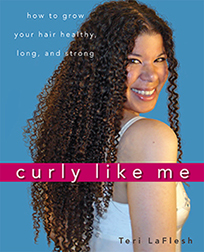
Available now!
Curly Like Me, the off-the-grid, do-it yourself owner's manual for tightly curly hair, is ready for ordering. Grab your copy today!

Every purchase made from
this site (through Amazon)
helps support it — and it
doesn't cost you anything
extra.
|
|
In the ingredient descriptions: Good means that I like to see this in a product's list of ingredients. Okay means this product appears safe for a curly person like me to use. Caution means that this ingredient may not be good in some hair care products, or for some people. Avoid means this ingredient may hurt your hair. If you see this ingredient in a hair product, it's best to put it down and walk away.
|
|
| |
Collagen
(aka Soluble collagen; Tropocollagen; Hydrolyzed collagen, Hydrolyzed animal protein)
Okay
Collagen is a type of protein found in animal tissue such as ligaments, tendons, bone, or skin. Collagen fibers are long and thin. They aren’t water-soluble. Collagen can be further broken down by hydrolysis into Gelatin, Hydrolyzed animal protein and Collagen Amino acids, all of which may be used in conditioners.
Collagen is known to make a more rigid film on the hair, and it tends to flake. Since Collagen by itself isn’t water soluble, and therefore isn’t moisturizing, it’s most likely that it’s Soluble collagen that’s actually being used.
Collagen is also put in products for its marketing appeal. Since aging causes us to lose collagen, it’s believed that applying it can restore youth and health. However, even if this can help reduce aging when it’s topically applied to the skin, it cannot help the hair, since not only is our hair not alive, but it’s also make of keratin-—not collagen.
(see also: Soluble collagen) [Hunting (Conditioning) Pages 349-352 & 161-162].
See also:
Protein
Source(s):
Hunting
|
Collagen amino acids
Caution
This is a very strong humectant, helping pull water in from the hair more so than even glycerin. This also binds really well to the hair. Collagen amino acids are a mixture of amino acids that come from purified Collagen that has been broken down by hydrochloric acid. This mixture is composed mostly of the amino acids Glycine, Proline, Hydroxyproline, Glutamic acid, Alanine, and Arginine. It has strong marketing appeal because it’s seen as a natural ingredient. It’s available as a yellow liquid that may or may not contain salt. There is a version of it that contains salt, and this version may contain up to 20% sodium chloride [Hunting (Conditioning) pg 162].
See also:
Collagen Protein Amino acids Sodium chloride
Source(s):
Hunting
|
|
References:
Applewhite, Thomas H., ed. Proceedings of the World Conference on Lauric Oils: Sources, Processing, and Applications
AOCS Publishing, 1994.
Barel, André O., Marc Paye, and Howard I. Maibach., eds. Handbook of Cosmetic Science and Technology, Second Edition
Marcel Dekker, Inc., 2001.
Begoun, Paula. Don’t Go Shopping for Hair-Care Products Without Me. 3rd Edition.
Renton: Beginning Press, 2005.
Begoun, Paula. The Beauty Bible.
Renton: Beginning Press, 2002.
Begoun, Paula. Don’t Go to the Cosmetics Counter Without Me.
Renton: Beginning Press, 2003.
Bellum, Sarah, ed. The Beauty Brains: Real Scientists Answer Your Beauty Questions
New York: Brains Publishing, 2008.
Gottschalk, Tari E. and McEwen, Gerald N, Jr. PhD, eds. International Cosmetic Ingredient Dictionary and Handbook, Tenth Edition 2004, Volumes 1-4.
Washington D. C.: The Cosmetic, Toiletry, and Fragance Association, 2004.
Halal, John Hair Structure and Chemistry Simplified, Fifth Edition
Albany: Milady, 2002.
Hunting, Anthony L.L. Encyclopedia of Conditioning Rinse Ingredients.
Cranford, NJ: Micelle Press, Inc., 1987.
Hunting, Anthony L.L. Encyclopedia of Shampoo Ingredients.
Cranford, NJ: Micelle Press, Inc., 1983.
Johnson, Dale H. (Ed.). Hair and Hair Care, Cosmetic Science and Technology Series. Vol. 17.
New York: Marcel Dekker, 1997. Print.
Nnanna, Ifendu A. and Jiding Xia., eds. Protein-Based Surfactants: Synthesis: Physicochemical Properties, and Applications (Surfactant Science)
Madison Heights: CRC, 2001.
Quadflieg, Jutta Maria. Fundamental properties of Afro-American hair as related to their straightening/relaxing behaviour.
Diss. U of Rheinisch-Westfälischen Technischen Hochschule Aachen, 2003.
Schueller, Randy and Perry Romanowski, eds. Conditioning Agents for Hair and Skin.
New York: Marcel Dekker, Inc., 1999.
Winter, Ruth M.S. A Consumer's Dictionary of Cosmetic Ingredients: Complete Information About the Harmful and Desirable Ingredients Found in Cosmetics and Cosmeceuticals
New York: Three Rivers Press, 2005.
Zviak, Charles., ed. The Science of Hair Care (Dermatology)
New York: Marcel Dekker, Inc., 1986.
|
|